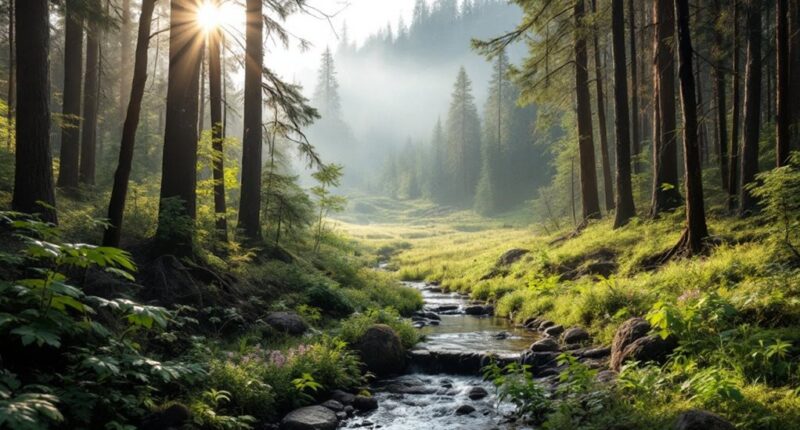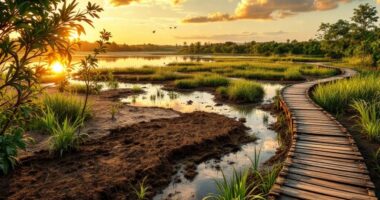Indigenous Environmental Knowledge represents one of humanity’s oldest ecological frameworks, blending practical skills with spiritual beliefs through generations of observation. Unlike Western science’s compartmentalized approach, indigenous practices recognize ecosystem interconnectedness and emphasize long-term sustainability. From Karuk controlled burns preventing wildfires to Inuit climate observations, these traditional approaches offer time-tested solutions to modern environmental challenges. As indigenous languages disappear and climate changes, preserving this ecological wisdom becomes increasingly urgent. The marriage of traditional knowledge with modern science might just hold the key to our sustainable future.

While modern science has only recently begun to appreciate the value of traditional wisdom, Indigenous Environmental Knowledge represents one of humanity’s oldest and most sophisticated ecological frameworks. Developed over countless generations through careful observation and lived experience, this rich tapestry of understanding weaves together practical skills, spiritual beliefs, and ecological insights that are precisely calibrated to local environments.
Think of it as the original “user’s manual” for Earth, written by its most attentive inhabitants.
This knowledge system operates like nature itself – holistically, cyclically, and with remarkable adaptability. Unlike Western science’s tendency to dissect and categorize, Indigenous knowledge sees the forest AND the trees, recognizing that everything from soil microbes to seasonal weather patterns forms an intricate web of relationships. It’s sustainability with a PhD in patience, refined through millennia of trial and error.
The applications are as diverse as the cultures that developed them. The Karuk and Yurok tribes of California, for instance, have practiced controlled burns for generations, effectively preventing the catastrophic wildfires that now plague the West.
Meanwhile, Inuit communities provide eerily accurate climate observations in the Arctic, often detecting subtle environmental shifts years before satellite data confirms them.
Sadly, this intellectual treasure faces serious threats. As indigenous languages disappear at alarming rates (one every two weeks!), volumes of ecological wisdom vanish with them. Environmental degradation and climate change further disrupt the ecosystems that these knowledge systems were designed to steward.
The good news? Scientists and policymakers are finally catching up. From wildfire management in Australia to biodiversity conservation in the Amazon, traditional approaches are increasingly recognized in environmental policy and research. This ancient wisdom encompasses biological and spiritual systems that provide a comprehensive understanding of our natural world. Such knowledge, established through rigorous observations over generations, offers invaluable insights that complement Western scientific methods.
Traditional land management practices have proven particularly effective for maintaining healthy ecosystems across forests, grasslands, and waterways alike.
This collaboration isn’t just about preserving ancient wisdom – it’s about survival. By integrating Indigenous knowledge with modern science, we gain a more complete understanding of our planet’s complex systems and potentially reveal solutions to our most pressing environmental challenges.
After all, who better to consult about sustainability than those who’ve practiced it successfully for thousands of years?
Frequently Asked Questions
How Do Indigenous Knowledge Systems Compare With Modern Science?
Indigenous knowledge systems and modern science represent different approaches to understanding our world.
Indigenous systems embrace holistic perspectives, oral transmission, and spiritual dimensions, while modern science employs reductionist methods, written documentation, and controlled experiments.
Where indigenous knowledge excels in sustainable environmental management developed over generations, modern science offers precise technological solutions.
The two approaches aren’t mutually exclusive—integration of these knowledge systems often yields more thorough environmental solutions and climate adaptation strategies.
Can Indigenous Knowledge Address Contemporary Environmental Crises?
Indigenous knowledge systems offer substantive solutions to modern environmental challenges. Their time-tested practices in wildfire management, sustainable agriculture, and water conservation demonstrate remarkable effectiveness.
While not a silver bullet, indigenous approaches provide valuable complements to scientific methods, particularly in local contexts. The integration of these knowledge systems with modern science creates a powerful toolbox for addressing climate change, biodiversity loss, and resource management challenges—especially when indigenous communities have decision-making authority.
What Are the Limitations of Indigenous Environmental Approaches?
Indigenous environmental approaches face several significant constraints.
Their localized nature often limits scalability to address global issues. Traditional practices frequently clash with modern development priorities and economic pressures.
There’s also continuous erosion of indigenous knowledge through displacement, colonization, and broken chains of intergenerational transmission.
Scientific validation presents another hurdle, as traditional approaches may lack the quantitative data valued by Western science, resulting in limited research funding and integration challenges.
How Is Indigenous Knowledge Documented and Preserved?
Indigenous knowledge is documented through ethnographic interviews, participatory mapping, and audio/video recordings.
Communities preserve this wisdom by establishing cultural centers, language programs, and mentorship initiatives that promote intergenerational knowledge transfer.
Digital archives and databases help safeguard information while collaborative fieldwork between researchers and communities guarantees ethical documentation.
Despite these efforts, challenges persist including language loss, funding constraints, intellectual property concerns, and the difficulty of translating complex cultural concepts into other languages.
Who Owns Indigenous Environmental Knowledge?
Indigenous environmental knowledge typically belongs collectively to indigenous communities rather than individuals.
It’s considered cultural heritage passed through generations, embedded in traditions and practices tied to specific territories.
Unlike conventional intellectual property systems, ownership is communal and interconnected with cultural identity.
International frameworks like the UN Declaration on Rights of Indigenous Peoples recognize these collective rights, though challenges persist with biopiracy, where corporations exploit this knowledge without proper consent or benefit-sharing arrangements with the originating communities.









